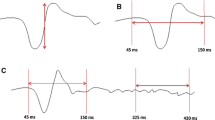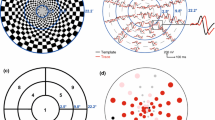Abstract
The peak latency of the pattern-reversal visual evoked potential is a sensitive measure of conduction delay in the optic nerve caused by demyelination. Despite its clinical utility, the pattern-reversal visual evoked potential has not previously been used in multicenter clinical trials, presumably because of difficulty in standardizing conditions between centers. To establish whether the pattern-reversal visual evoked potential could be adequately standardized for use as a measure in multicenter therapeutic trials for optic neuropathy or multiple sclerosis, stimulus and recording variables were equated at four centers and pattern-reversal visual evoked potentials were recorded from 64 normal subjects and 15 patients with resolved optic neuritis. Results showed equivalent latency and amplitude data from all centers, suggesting that stimulus and recording variables can be satisfactorily standardized for multicenter clinical trials. N70 and P100 peak latencies and N70-P100 interocular amplitude difference were sensitive measures of resolved optic neuritis.
Similar content being viewed by others
Abbreviations
- ANOVA:
-
analysis of variance
- ON:
-
optic neuritis
References
Ormerod IEC, Miller DH, McDonald WI, et al. The role of NMR imaging in the assessment of multiple sclerosis and isolated neurological lesions. Brain 1987; 110: 1579–1616.
Miller DH, Newton MR, Van der Poel JC, et al. Magnetic resonance imaging of the optic neuritis. Neurology 1988; 38: 175–9.
Paty DW, Oger JJ, Kastrukoff LF, et al. MRI in the diagnosis of MS: A prospective study with comparison of clinical evaluation, evoked potentials, oligoclonal banding and CT. Neurology 1988; 38: 180–5.
Celesia GG, Kaufman DI, Brigell M, et al. Optic neuritis: A prospective study. Neurology 1990; 40: 919–23.
Augustinus B, Van den Bergh L, Zeyen T. Vistech contrast sensitivity and pattern-VEP in multiple sclerosis patients. Bull Soc Belge Ophtalmol 1990; 236: 89–96.
Leys MJJ, Candaele CMLJ, De Rouck AF, Odom JV. Detection of hidden visual loss in multiple sclerosis: A comparison of pattern-reversal visual evoked potentials and contrast sensitivity. Doc Ophthalmol 1991; 77: 255–64.
Chiappa KH. Physiologic localization using evoked responses: Pattern shift visual, brainstem auditory and short latency somatosensory. In: Thompson RA, Green JR, eds. New perspectives in cerebral localization. New York: Raven Press, 1982: 63–114.
Halliday AM, McDonald WI, Mushin J. Delayed pattern evoked responses in optic neuritis in relation to visual acuity. Trans Ophthalmol Soc U K 1973; 93: 315–24.
Halliday AM, McDonald WI, Mushin J. Delayed visual evoked responses in optic neuritis. Lancet 1972 (i): 982–5.
Asselman P, Chadwick DW, Marsden CD. VEPs in the diagnosis and management of patients suspected of multiple sclerosis. Brain 1975; 98: 261–82.
Milner BA, Regan D, Heron JR. Differential diagnosis of multiple sclerosis by VEP recording. Brain 1974; 97: 755–72.
Celesia GG, Daly RF. VECA: A new electrophysiological test for the diagnosis of optic nerve lesions. Neurology 1977; 27: 637–41.
Halliday AM, McDonald WI. Pathophysiology of demyelinating disease. Br Med Bull 1977; 33: 21–7.
Chiappa KH, ed. Evoked potentials in clinical medicine. New York: Raven Press, 1989.
Beck RW, Cleary MS, Anderson MM, et al. A randomized, controlled trial of corticosteroids in the treatment of acute optic neuritis. N Engl J Med 1992; 326: 581–8.
Cant BR, Hume AL, Shaw NA. Effects of luminance on the pattern evoked potential in multiple sclerosis. Electroencephalogr Clin Neurophysiol 1978; 45: 496–504.
Campbell FW, Maffei L. Electrophysiological evidence for the existence of orientation and size detectors in the human visual system. J Physiol 1970; 207: 635–52.
Wright MJ, Johnston A. The effects of contrast and length of gratings on the visual evoked potential. Vision Res 1982; 22: 1389–99.
Armington JC, Corwin TR, Marsetta W. Simultaneously recorded retinal and cortical responses to patterned stimuli. J Opt Soc Am 1971; 61: 1514–21.
Parker DM, Salzen EA. The spatial sensitivity of early and late waves within the human visual evoked response. Perception 1977; 6: 85–95.
Pearson ES, Hartley HO. Charts of the power function for analysis of variance tests derived from the non-central F-distribution. Biometrika 1951; 38: 112–30.
Diener HC, Scheibler H. Follow-up studies of visual potentials in multiple sclerosis evoked by checkerboard and foveal stimulation. Electroencephalogr Clin Neurophysiol 1980; 49: 490–6.
Becker WJ, Richards IM. Serial pattern shift visual evoked potentials in multiple sclerosis. Can J Neurol Sci 1984; 11: 53–9.
Aminoff MJ, Ochs AL. Pattern-onset visual evoked potentials in suspected multiple sclerosis. J Neurol Neurosurg Psychiatry 1981; 44: 608–14.
Hammond SR, MacCallum S, Yiannikas C, Walsh JC, McLeod JG. Variability on serial testing of pattern reversal visual evoked potential latencies from full-field, half-field and foveal stimulation in control subjects. Electroencephalogr Clin Neurophysiol 1987; 66: 401–8.
Oken BS, Chiappa KH, Gill E. Normal temporal variability of the P100. Electroencephalogr Clin Neurophysiol 1987; 68: 153–6.
Shahrokhi F, Chiappa KH, Young RR. Pattern shift evoked responses. Arch Neurol 1978; 35: 65–71.
Persson HE, Sachs C. Visual evoked potentials elicited by pattern reversal during provoked visual impairment in multiple sclerosis. Brain 1981; 104: 369–82.
Kupersmith MF, Nelson JI, Seiple WH, Carr RE, Weiss PA. The 20/20 eye in multiple sclerosis. Neurology 1983; 33: 1015–20.
Heinrichs IH, McLean DR. Evolution of visual evoked potentials in optic neuritis. Can J Neurol Sci 1988; 15: 394–6.
Stefano E, Culini LM, Rizzo P, Pierelli F, Rizzo PA. Simultaneous recording of pattern electroretinogram (PERG) and visual evoked potential (VEP) in multiple sclerosis. Acta Neurol Belg 1991; 19: 20–8.
DeVoe RG, Ripps H, Vaughan HG Jr. Cortical responses to stimulation of the human fovea. Vision Res 1968; 8: 135–47.
Armington JC, Brigell MG. The effects of stimulus location and pattern upon visual evoked potential and electroretinogram. Int J Neurosci 1981; 14: 169–78.
Rosner B. Statistical methods in ophthalmology: An adjustment for the intraclass correlation between eyes. Biometrics 1982; 38: 105–14.
Plant GT, Zimmern RL, Durden K. Transient visual evoked potentials to the pattern reversal and onset of sinusoidal gratings. Electroencephalogr Clin Neurophysiol 1983; 56: 137–58.
Hennerici M, Wenzel D, Freund JH. The comparison of small-size rectangle and checkerboard stimulation for the evaluation of delayed visual evoked responses in patients suspected of multiple sclerosis. Brain 1977; 100: 119–36.
Ikeda H, Tremain KE, Sanders MD. Neurophysiological investigation in optic nerve disease: Combined assessment of the visual evoked response and electroretinogram. Br J Ophthalmol 1978; 62: 227–39.
Aminoff MJ, Davis SL, Panitch HS. Serial evoked potential studies in patients with definite multiple sclerosis. Arch Neurol 1984; 41: 1197–202.
McDonald WI, Barnes D. Lessons from magnetic resonance imaging in multiple sclerosis. Trends Neurosci 1989; 12: 376–9.
Schauf CL, Pancek TL, Davis FA, Rooney MW. Physiologic basis for neuroelectric blocking activity in multiple sclerosis. Neurology 1981; 31: 1338–41.
McDonald WI, Sears TA. The effects of experimental demyelination on conduction in the central nervous system. Brain 1970; 93: 583–98.
Cohen MM, Lessell S, Wolf PA. A prospective study of the risk of developing multiple sclerosis in uncomplicated optic neuritis. Neurology 1979; 29: 208–13.
Kakisu Y, Adachi-Usami E, Fujimoto N. Pattern visually evoked cortical potential and magnetic resonance imaging in optic neuritis. J Clin Neuro-Ophthalmol 1991; 11: 205–12.
Turano G, Jones SJ, Miller DH, Du Boulay GH, Kakigi R, McDonald WI. Correlation of SEP abnormalities with brain and cervical cord MRI in multiple sclerosis. Brain 1991; 114: 663–81.
Author information
Authors and Affiliations
Rights and permissions
About this article
Cite this article
Brigell, M., Kaufman, D.I., Bobak, P. et al. The pattern visual evoked potential. Doc Ophthalmol 86, 65–79 (1994). https://doi.org/10.1007/BF01224629
Accepted:
Issue Date:
DOI: https://doi.org/10.1007/BF01224629




